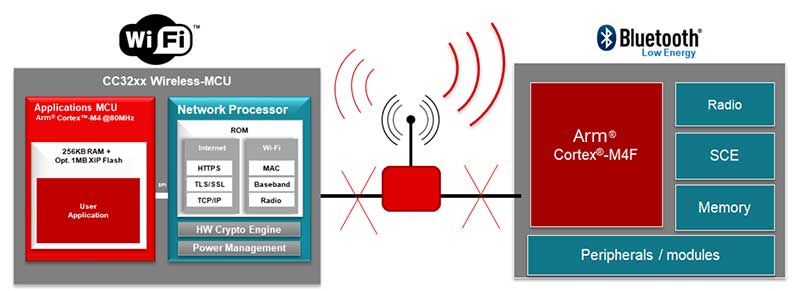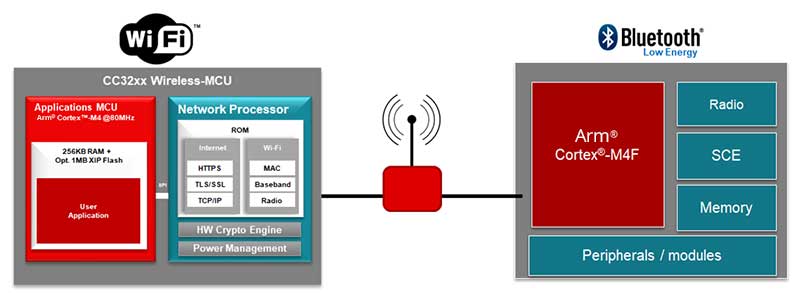SSZT143 july 2021 CC2642R , CC2652P , CC2652R , CC2652RB , CC3230S , CC3230SF , CC3235S , CC3235SF
Kevin Koestler co-authored this article.
Have you ever been in a crowded hallway with people talking at the same time? Only those talking loudest can be heard. However, if each person talks one at a time, everyone’s communication can be heard clearly even in the same crowded space. This scenario is similar to the wireless spectrum and the increasing number of connected devices.
The 2.4 GHz band is widely used in building automation and medical applications and is one such band with a lot of congestion. Several popular protocols, like Wi-Fi®, Bluetooth® and others, utilize the same 2.4-GHz unlicensed frequency band where there is a lot of noise and interference that can result in transmission errors. For example, in a patient monitoring gateway, a higher power Wi-Fi radio could interfere with an adjacent low power Bluetooth® Low Energy radio that is used to communicate with remote patient monitoring sensors operating concurrently. This could cause a serious impact on patient data without a coexistence mechanism.
Therefore, the need for coexistence to manage the Wi-Fi plus Bluetooth Low Energy communications can be critical. A robust and reliable communication is a must with these competing protocols. Coexistence between radios minimize the potential for interference when used concurrently in the same frequency band. Furthermore, having a two-chip solution with two radios provides a robust radio performance, enables lower power consumption and increased security capabilities.
An HVAC gateway or a medical patient monitoring system, are good examples of use cases that can take advantage of a Wi-Fi plus Bluetooth Low Energy solution. Wi-Fi is used to securely connect the system to the cloud to allow for remote monitoring, command and control. Additionally, the Bluetooth Low Energy device can be used to provision the HVAC controllers’ Wi-Fi to the local network. Bluetooth Low Energy can also be used to monitor various low power Bluetooth Low Energy sensor nodes and aggregate the data at the HVAC controller or patient monitor which then transmits the data to the cloud for processing.
When both the Wi-Fi and Bluetooth Low Energy radios need to operate concurrently, the systems’ coexistence feature allows the traffic to be managed in such a way to minimize interference. Otherwise, this interference will be the most prevalent in the Bluetooth Low Energy device since the Wi-Fi radio operates at a much higher output power level, as shown in Figure 1.
 Figure 1 Systems without Coexistence Where the Wi-Fi Radio Interferes with the Bluetooth Low Energy Radio When Used in Concurrent Mode of Operation
Figure 1 Systems without Coexistence Where the Wi-Fi Radio Interferes with the Bluetooth Low Energy Radio When Used in Concurrent Mode of OperationCoexistence between radios enable products to achieve better concurrent communications which otherwise could be compromised due to the radios’ interference with one another within the 2.4-GHz band. Having independent radios with coexistence support minimizes this issue since the traffic management is handled by the coexistence algorithm as shown in Figure 2. Additionally, a 2-chip Wi-Fi and Bluetooth Low Energy 5.x solution with integrated coexistence can have additional benefits with their independent and optimized architectures. The dual radio architecture enables better sensitivity, allowing for longer range, lower power consumption when compared to a shared single chip radio approach and a complete set of security enablers.
 Figure 2 A System with Integrated Coexistence Minimizes Interference with One Another’s 2.4 GHz Radios When Used in Concurrent Mode of Operation
Figure 2 A System with Integrated Coexistence Minimizes Interference with One Another’s 2.4 GHz Radios When Used in Concurrent Mode of OperationAdditionally, low power consumption is an important factor for Wi-Fi plus Bluetooth Low Energy enabled battery-operated products. The Wi-Fi device has configurable low power profiles with a 4.5 μA hibernate mode with a fast and secure TLS/SSL connection on wake up to the access point in under 200 msec. With its unique network learning algorithm, it further enables a consistent and reliable low power connection to a variety of access points as tested with >230 different ones as of today. Similarly, the Bluetooth Low Energy device also has extremely low 0.94 μA standby current with excellent sensitivity of –97 dBm enabling longer range with a max +5 dBm output power.
The two-chip architectures further enable increased security by taking advantage of the both Wi-Fi and Bluetooth Low Energy security features such as hardware encryption, secure boot, application level security and secure over the air (OTA). The Wi-Fi device also incorporates the latest personal and enterprise level WPA3 support, TI root-of-trust public key, encrypted and authenticated executables enable barriers to resist cloning and hacking. The integration of the coexistence via a 1-wire interface between the devices also minimizes the number of IO lines making it available for other sensors or peripherals.
Similar to the gateway, other types of products in home automation, medical can benefit from the coexistence feature on top of the security, optimized low power and reliable communications achieved with a 2-chip system. So, it’s even more important today for designers to pay extra attention and maintain robust communications and minimize interference in a congested and noisy environment with technologies operating in the same frequency 2.4 GHz band.
To learn more about the benefits of the two-chip solution, TI provides ease of design and support with our reference design. Find a broad portfolio of scalable devices, EVMs and tools.
- Bluetooth Low Energy:
- Products: CC2642R, CC2652P, CC2652R, CC2652RB
- EVM: LAUNCHXL-CC26x2R1
- Wi-Fi:
- Products: CC3230S, CC3230SF, CC3235S, CC3235SF
- EVM: LAUNCHXL-CC3235S - Buy now at 25% with promo code COEXWIFI. Offer expires 1/21/2022.